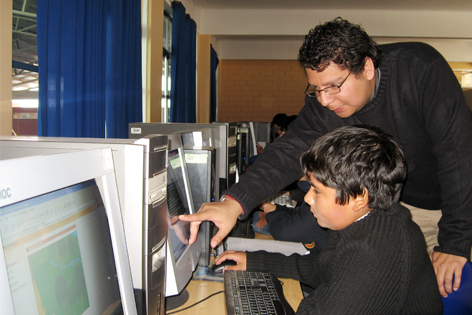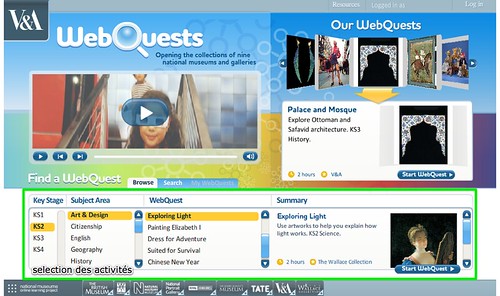MET:World of WebQuests
This page was created by Perdeep Samra, 2009. Edited by Meggan Crawford, May, 2011.
 |
| A teacher guides a student through a webquest.Creative Commons image.[1] |
Introduction to Webquests
The WebQuest is the brainchild of San Diego State University professor Bernie Dodge and Tom March[2]. Dodge defines WebQuests in the following manner: “A WebQuest is an inquiry-oriented activity in which most or all of the information used by learners is drawn from the web. WebQuests are designed to use learners’ time well, to focus on using information rather than looking for it, and to support learners’ thinking at the levels of analysis, synthesis, and evaluation”[3]. The explosion of WebQuests on the internet since 1995 is amazing. As of June, 2011 a Google internet search using the word WebQuest reveals well over five million results.
Types of WebQuests
Dodge has outlined two main types of WebQuests. A short term WebQuest usually takes one to three hours to complete. The main goal of a short term WebQuest is to help the learner acquire knowledge on a specific topic. The second type of WebQuest is called a long term WebQuest, which usually takes a from a week to an entire month to complete. Long term WebQuests are not only used to acquire knowledge on a topic, but also to extend and refine that knowledge.[4] WebQuests can be used in many subject areas and grade levels. These subject areas include: Science, Social Studies, Mathematics and Physical Education. A WebQuest does not have to focus on a single discipline as they can also be designed in an interdisciplinary fashion.[5]
Webquests in the Classroom
Use in Elementary Level Classrooms
WebQuests present a means of reaching students at various levels of learning, particularly within the elementary school classroom where learners are often spread throughout levels of reading and comprehension abilities. Since WebQuests utilize multiple sites they often allow learners to find a comfort zone while still obtaining the requisite knowledge. Additionally, WebQuests align well with Multiple_Intelligences[6], helping teachers to more easily differentiate learning to reach all learners. In the same vein, WebQuests can more easily utilize images, allowing for early readers to learn without as much of a need for lectures.
 |
| The webquest site for the Victoria & Albert Museum.[7] |
Use in Secondary Level Classrooms
Within secondary schools WebQuests provide a means for classes to work with technology and to cover more information in a shorter time than they may otherwise be able to manage. There is the risk of students visiting sites that are unrelated to the WebQuest,[8] but this is a risk inherent in any computer usage. At the secondary level the ability to integrate information from around the world, such as the WebQuests provided by the Victoria & Albert museum, makes them a powerful tool to bring global awareness and breadth of information to the classroom.
Use in Post Secondary Classrooms
WebQuests have earned a place in many courses for preservice teachers as a means of demonstrating the potential inherent in bringing technology to the classroom. By encouraging preservice and new teachers to utilize WebQuests many people “came to see WebQuests as a way to guide the students through the problem-solving process and prepare them for less structured problem- solving activities later in our courses”[9] These elements, combined with the relative ease of use of WebQuests makes them a strong option for preservice teachers, but also for use in post secondary classes in many subject areas.
Components of a WebQuest
According to Halat[10] a WebQuest consists of six main components:
| Six Main Components | |
|---|---|
| Introduction: | Students are introduced to the learning outcomes and objectives of the WebQuest. |
| Task: | This section outlines the main task to be completed. It also outlines sub-tasks that must be completed prior to the main task. Sub-tasks are simple tasks that provide students with the background knowledge needed to complete the main task. |
| Process: | Explains how the learners should complete the main task. |
| Resources: | Contains a list of web site links needed to complete the main task and sub-tasks. |
| Evaluation: | A rubric used by students to evaluate their own progress or by a teacher to evaluate their students’ progress. |
| Conclusion: | Summarizes what students learned (or should have learned) and provides extension ideas for further learning. |
These six components are further supported as being central to WebQuests by Lacina[11] who also lists several sites that have strong WebQuests based upon these elements.
What makes Effective and Ineffective WebQuests?
Effective WebQuests/Strengths of WebQuests
In order to be effective, WebQuests need to follow the six main components mentioned in the previous section. Effective WebQuests also give students an opportunity to think critically about a topic, require students to apply the knowledge they have learned in a meaningful manner, teach students to work in small groups, and provide scaffolding (to aid student learning). Lastly, WebQuests should interest the learner. If the WebQuest does not interest the learner they may not be motivated to complete it.[12]
Teaching through WebQuests has many strengths. Firstly, WebQuests have the ability to increase student motivation levels. Secondly, WebQuests allow students to become active learners.[13] Thirdly, students practice auditory, visual, reading, thinking, and problem solving skills while they are completing a WebQuest. Lastly, WebQuests narrow down the vast array of web pages available on any given topic.[14] Students spend more time learning about a topic rather than navigating through terrible web sites in order to find a diamond in the rough.
 |
| A logo celebrating well made WebQuests.[15] |
Ineffective WebQuests/Weaknesses of WebQuests
Ineffective WebQuests tend not to follow the six main components. For example, a poorly designed WebQuest may simply be an electronic worksheet or a list of web sites to visit without giving the learner a task to focus on. Ineffective WebQuests may also rely on rote memorization.[16]
There are also many weaknesses associated with WebQuests. Firstly, students may become side tracked and visit web sites that are completely off topic, as mentioned above.[17] Secondly, making an excellent WebQuest consumes a great deal of time. Lastly, students that have poor computer skills may find it difficult to complete a WebQuest.[18]
Do WebQuests aid Student Learning?
More research is clearly needed to answer this question in a definitive manner, however some research suggests that the scaffolding present in WebQuests increases student achievement.[19] Other research, however, shows that traditional teaching techniques are more effective than WebQuests.[20]
Problem-Based Learning
Problem-Based_Learning encourages critical thinking and engagement with material on a higher level of understanding. WebQuests rely on problem-based learning to engage the learners and to attain this higher level thinking. The use of problem-based learning is, in part, why WebQuests are being encouraged among preservice teachers.[21] Additionally, however, the inclusion of this type of learning makes WebQuests a more active approach to learning and engaging with information.[22]
Making a WebQuest
There are many elements that must be considered in constructing a WebQuest, with several theories suggesting which elements are most important.
Dodge & FOCUS
Dodge suggests using the acronym FOCUS, as described below, to guide the creation of a WebQuest at any level.[23]
| F | Find great sites that match age group, topic, goals, etc. They should be up to date and new to students. Using search engines’ advanced options is helpful. |
| O | Orchestrate learners and resources to ensure everyone has something to do and you use resources well. Cooperative learning strategies can help inspire students to keep learning after leaving the computers. |
| C | Challenge learners to think. Aim to have your students engaging and doing more than just research. |
| U | Use the medium of a WebQuest in different ways and with different media to take advantage of the options. Make sure you are staying on task so that your choices do not overwhelm the focus. |
| S | Scaffold to support high expectations. With enough scaffolding you will be giving your students the help they need to work and think at a higher level. |
March & the 3 R's
Tom March, in contrast, suggest using the "3 R's" to design successful WebQuests, as described below.[24]
| REAL | Your topic should connect to the real world, encourage critical analysis, and you must provide real world feedback. |
| RICH | Allow the students to fully realize themes and to establish relationships. The Internet ought to be enriching the task, not just giving instructions. |
| RELEVANT | The learners need to be able to find relevancy. It is best to “use the wealth of the Web’s resources to ‘learn globally,’ but ask students to ‘decide locally’ when it comes to the Task.”[25] |
Related Links
- webquest.org Informative site created by Bernie Dodge that contains 2500 WebQuests. This site also contains information on how to create WebQuests and is a good source for them overall.
- The site also mentions a WebQuest Resarch Consortium for anyone who is interested in conducting research on WebQuests. If you are looking for more information, email bdodge@mail.sdsu.edu
- The latest news feed on the site is dated from October 2008, so it is possible the site is no longer being updated. The information and WebQuests it has, however, are still valid and worth a look!
- bestwebquests.com This site contains many excellent WebQuests for all age levels and is still run and updated by Tom March.
- Canadian WebQuests along with various other Canadian focused activities.
- A beginner’s guide to WebQuests, this tutorial shows you a step by step basic look at what WebQuests are and how you can both use and create them.
- A site for making WebQuests. The format is consistent, but you retain control over the content.
- A strong list of resources for WebQuests.
- A pdf of a detailed presentation on WebQuests by Kathleen Schrock.
References
Bausson, S. (2009). Webquests. Retrieved from http://www.flickr.com/photos/samuelbausson/3394771317/sizes/m/in/photostream/ July 1st, 2011.
Dodge, B. (2001). FOCUS: Five rules for writing a great WebQuest. Learning & Leading with Technology, 28(8), 6-9.
Gardner, H. (1991). The unschooled mind. how children think and how schools should teach. New York: Basic Books.
Gardner, H. (1993). Multiple intelligences: The theory in practice. New York: Basic Books.
Gardner, H. (1997). Reflections on multiple intelligences: Myths and messages. Phi Delta Kappan, 78(5), 200-207.
Gaskill, M., McNulty, A., & Brooks, D. W. (2006). Learning from WebQuests. Journal of Science Education and Technology, 15(2), 133-136. doi:10.1007/s10956-006-9005-7.
Halat, E. (2008). A good teaching technique: WebQuests. Clearing House: A Journal of Educational Strategies, Issues and Ideas, 81(3), 109-112. doi:10.3200/TCHS.81.3.109-112.
judit10. (2010). webquest_white. Retrieved from http://www.flickr.com/photos/43657698@N04/4257871860/ July 2nd, 2011.
Lacina, J. (2007). Inquiry-based learning and technology: Designing and exploring WebQuests Childhood Education, 83(4), 251-252.
Liceo Nacional de Maipú. (2007). WQ1.jpg Retrieved from http://commons.wikimedia.org/wiki/File:WQ1.jpg
Maddux, C. D., & Cummings, R. (2007). WebQuests: Are they developmentally appropriate? The Educational Forum, 71(2), 117-127.
March, T. (2000). The 3 R's of WebQuests. Multimedia Schools, Retrieved from westnet.net.aut
March, T. (2004). The learning power of WebQuests. Educational Leadership, Retrieved from http://tommarch.com/writings/wq_power.php
Perkins, R., & McKnight, M. L. (2005). Teachers’ attitudes toward WebQuests as a method of teaching. Computers in the Schools, 22(1), 123-133.
Smith, L. K., Draper, R. J., & Sabey, B. L. (2005). The promise of technology to confront dilemmas in teacher education: The use of WebQuests in problem-based methods courses Journal of Computing in Teacher Education, 21(4), 99-108.
Tomlinson, C. A. (1999). The differentiated classroom: Responding to the needs of all learners. Virginia: Association for Supervision and Curriculum Development.
Zheng, R., Stucky, B., McAlack, M., Menchaca, M., & Stoddart, S. (2005). WebQuest learning as perceived by higher-education learners. Tech Trends: Linking Research & Practice to Improve Learning, 49(4), 41-42-29. Retrieved from http://www.hci.sg/admin/uwa/MEd7_8633/Survey1.pdf
Notes
- ↑ Liceo Nacional de Maipú. (2007). WQ1.jpg Retrieved from http://commons.wikimedia.org/wiki/File:WQ1.jpg July 1st, 2011.
- ↑ Zheng, R., Stucky, B., McAlack, M., Menchaca, M., & Stoddart, S. (2005). WebQuest learning as perceived by higher-education learners. Tech Trends: Linking Research & Practice to Improve Learning, 49(4), 41-49. Retrieved from http://www.hci.sg/admin/uwa/MEd7_8633/Survey1.pdf
- ↑ Maddux, C. D., & Cummings, R. (2007). WebQuests: Are they developmentally appropriate? The Educational Forum, 71(2), 117-127.
- ↑ Zheng, R., Stucky, B., McAlack, M., Menchaca, M., & Stoddart, S. (2005). WebQuest learning as perceived by higher-education learners. Tech Trends: Linking Research & Practice to Improve Learning, 49(4), 41-49. Retrieved from http://www.hci.sg/admin/uwa/MEd7_8633/Survey1.pdf
- ↑ Zheng, R., Stucky, B., McAlack, M., Menchaca, M., & Stoddart, S. (2005). WebQuest learning as perceived by higher-education learners. Tech Trends: Linking Research & Practice to Improve Learning, 49(4), 41-49. Retrieved from http://www.hci.sg/admin/uwa/MEd7_8633/Survey1.pdf
- ↑ Gardner, H. (1991). The unschooled mind. how children think and how schools should teach. New York: Basic Books.
Gardner, H. (1993). Multiple intelligences: The theory in practice. New York: Basic Books.
Gardner, H. (1997). Reflections on multiple intelligences: Myths and messages. Phi Delta Kappan, 78(5), 200-207. - ↑ Bausson, S. (2009). Webquests. Retrieved from http://www.flickr.com/photos/samuelbausson/3394771317/sizes/m/in/photostream/ July 1st, 2011.
- ↑ Halat, E. (2008). A good teaching technique: WebQuests. Clearing House: A Journal of Educational Strategies, Issues and Ideas, 81(3), 109-112. doi:10.3200/TCHS.81.3.109-112.
- ↑ Smith, L. K., Draper, R. J., & Sabey, B. L. (2005). The promise of technology to confront dilemmas in teacher education: The use of WebQuests in problem-based methods courses Journal of Computing in Teacher Education, 21(4), p.106.
- ↑ Halat, E. (2008). A good teaching technique: WebQuests. Clearing House: A Journal of Educational Strategies, Issues and Ideas, 81(3), 109-112. doi:10.3200/TCHS.81.3.109-112
- ↑ Lacina, J. (2007). Inquiry-based learning and technology: Designing and exploring WebQuests Childhood Education, 83(4), 251-252.
- ↑ Zheng, R., Stucky, B., McAlack, M., Menchaca, M., & Stoddart, S. (2005). WebQuest learning as perceived by higher-education learners. Tech Trends: Linking Research & Practice to Improve Learning, 49(4), 41-49. Retrieved from http://www.hci.sg/admin/uwa/MEd7_8633/Survey1.pdf
- ↑ Halat, E. (2008). A good teaching technique: WebQuests. Clearing House: A Journal of Educational Strategies, Issues and Ideas, 81(3), 109-112. doi:10.3200/TCHS.81.3.109-112
- ↑ Perkins, R., & McKnight, M. L. (2005). Teachers’ attitudes toward WebQuests as a method of teaching. Computers in the Schools, 22(1), 123-133.
- ↑ judit10. (2010). webquest_white. Retrieved from http://www.flickr.com/photos/43657698@N04/4257871860/ July 2nd, 2011.
- ↑ Zheng, R., Stucky, B., McAlack, M., Menchaca, M., & Stoddart, S. (2005). WebQuest learning as perceived by higher-education learners. Tech Trends: Linking Research & Practice to Improve Learning, 49(4), 41-49. Retrieved from http://www.hci.sg/admin/uwa/MEd7_8633/Survey1.pdf
- ↑ Halat, E. (2008). A good teaching technique: WebQuests. Clearing House: A Journal of Educational Strategies, Issues and Ideas, 81(3), 109-112. doi:10.3200/TCHS.81.3.109-112
- ↑ Perkins, R., & McKnight, M. L. (2005). Teachers’ attitudes toward WebQuests as a method of teaching. Computers in the Schools, 22(1), 123-133.
- ↑ March, T. (2004). The learning power of WebQuests. Educational Leadership, Retrieved from http://tommarch.com/writings/wq_power.php
- ↑ Gaskill, M., McNulty, A., & Brooks, D. W. (2006). Learning from WebQuests. Journal of Science Education and Technology, 15(2), 133-136. doi:10.1007/s10956-006-9005-7
- ↑ Smith, L. K., Draper, R. J., & Sabey, B. L. (2005). The promise of technology to confront dilemmas in teacher education: The use of WebQuests in problem-based methods courses Journal of Computing in Teacher Education, 21(4), 99-108.
- ↑ Tomlinson, C. A. (1999). The differentiated classroom: Responding to the needs of all learners. Virginia: Association for Supervision and Curriculum Development.
- ↑ Dodge, B. (2001). FOCUS: Five rules for writing a great WebQuest. Learning & Leading with Technology, 28(8), 6-9.
- ↑ March, T. (2000). The 3 R's of WebQuests. Multimedia Schools, Retrieved from westnet.net.aut
- ↑ March, T. (2000). The 3 R's of WebQuests. Multimedia Schools, Retrieved from westnet.net.aut. p.3